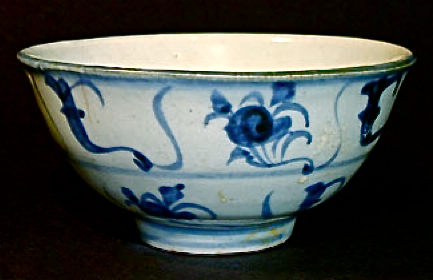

Title: Antique Chinese Qing Ching Dynasty Blue & White Small Bowl
Shipping: $29.00
Artist: N/A
Period: 20th Century
History: N/A
Origin: Southern Asia > Philippines
Condition: Museum Quality
Item Date: 1910
Item ID: 6029
A small blue and white bowl from the late Ching dynasty 1910. In perfect condition and glaze. Trade export ware found in southern Philippines in 1968. Under the Ching, traditional forms of art flourished and innovations were made at many levels and in many types. High levels of literacy, a successful publishing industry, prosperous cities, and the Confucian emphasis on cultivation all fed a lively and creative set of cultural fields. Imperial patronage encouraged the industrial production of ceramics and Chinese export porcelain. By the end of the nineteenth century, all elements of national artistic and cultural life had recognized and begun to come to terms with world culture as found in the West and Japan. Staying within old forms or returning to ancient ones was now a conscious choice rather than unchallenged tradition. All of the art is edited and chosen by us for its high quality and workmanship before posting. These collectibles have been selected with the artist & collector in mind. We are committed to enhancing our customer’s lives by discovering creating, and pointing out only the best art we can find in the world today. We Are Taste-Makers, Art Advisers, Consultants & Publishers Of Spectacular Art Stories. Our job is to be intermediaries between buyers and sellers. We are vetting for high end art patrons. We are determined to catalog the world's most exceptional art and share it with everyone.
Link: http://en.wikipedia.org/wiki/Ching_Dynasty
The Qing Dynasty (Chinese: Empire of the Great Qing or Great Qing, was the last imperial dynasty of China, ruling from 1644 to 1912 with a brief, abortive restoration in 1917. It was preceded by the Ming Dynasty and succeeded by the Republic of China.
The dynasty was founded by the Jurchen Aisin Gioro clan in contemporary Northeastern China. In the late sixteenth century, Aisin Gioro leader, Nurhachi, who was originally a vassal of the Ming emperors, began forming the Jurchen clans into "Banners" a military-social unit which also included various ethnic groups. By 1635, Nurhachi's son Hong Taiji could claim the Manchus constituted a single and united Manchu people and began forcing the Ming out of southern Manchuria. In 1644, the Ming capital Beijing was sacked by a peasant revolt led by Li Zicheng, a former minor Ming official, who then proclaimed the Shun dynasty. The last Ming ruler, the Chongzhen Emperor, committed suicide when the city fell. Ming general Wu Sangui, threatened by Li, made an alliance with the Manchus and opened the Shanhai Pass to the Banner Armies. Under Prince Dorgon, they seized control of Beijing. Complete control of China proper was accomplished around 1683 under the Kangxi Emperor. Ten Great Campaigns of the Qianlong emperor from the 1750s to the 1790s extended control into Central Asia, but were less successful in South and Southeast Asia.